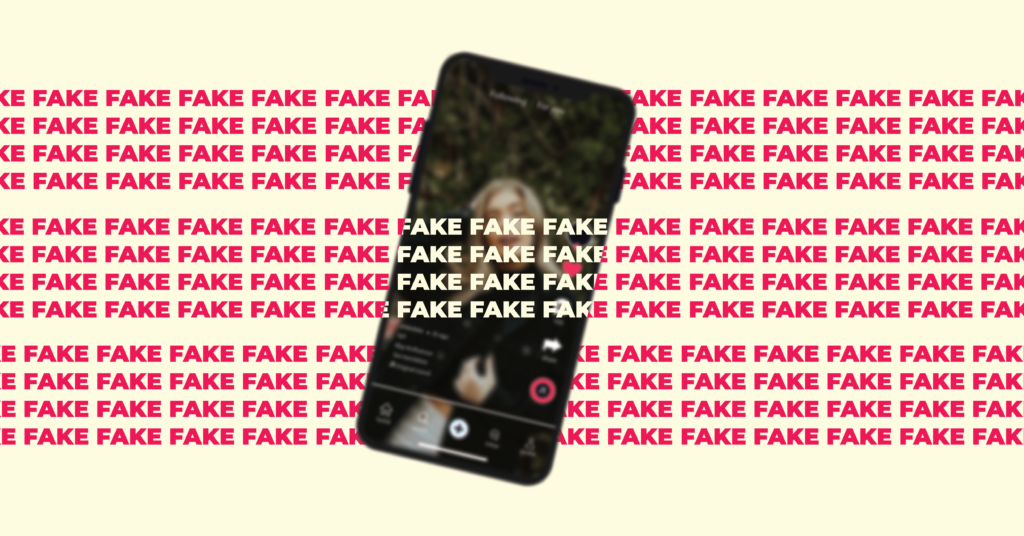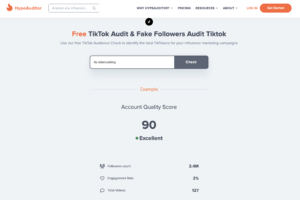Influencer marketing can bring incredible results for brands that know how to use it the right way. If you find the right creator to work with, pick the right platform and choose the best content strategy, you can quickly maximize your marketing RoI.
TikTok is now the hottest platform to take your brand to the next level – making your products more popular within your target audience, building trust and credibility, creating positive associations with the brand, and ultimately driving conversions.
However, such results aren’t guaranteed and can only be achieved with the right type of influencers and, needless to say, legit ones. In the best case, working with fake influencers on TikTok means a loss of funds; in the worse case, it will result in a PR disaster and harm your brand image and reputation, which may be hard to recover from.
One of the biggest dangers for marketers is coming across fake influencers on TikTok. Let’s talk about how to spot them so you don’t get into hot water.
What is a fake influencer?
Before learning how to spot fake influencers on TikTok, you need to know what is considered a fake account.
Sham TikTok influencers usually impersonate real influencers by posting high-quality images, faking relationships with big brands and pretending to lead high-quality lives. However the following of these accounts is often made up of other fake accounts or bots. Engagement might seem high on their posts, but that’s only because they purchased likes, comments and followers to raise their engagement artificially.
More concerningly, the person you see in these videos might not even be the actual owner of the account. In many cases, the fake influencer account is run by an entirely different person or group of persons trying to trick marketers and brands.
You wouldn’t believe how easy it is to become a fake influencer on TikTok: all it takes is to create an account, upload attractive content which can be stolen from other platforms or stock services, and buy followers from one of the many packages that offer this “service” to appear legit.
How can you catch fake influencers on TikTok?
In most cases, fake influencers’ content will appear impeccable because there is a sophisticated strategy behind it. They know how to make you believe that it’s all real and that you can trust them.
Nevertheless, there are still a couple of factors that can tell you whether someone’s account is real or not: their followers, engagement ratio, and engagement quality. Another red flag is whether the influencer can provide references from their previous brand partnerships or isn’t willing to.
1. Followers
This is probably the simplest way to spot a fake TikTok influencer page. The quality of the audience can tell you a lot about the creator and whether you can trust them. An audience quality check is the first thing you should do.
When you look at a fake account’s followers, you can usually see something’s wrong from the first glance. In most cases, there will be many accounts without profile photos. When you go into these follower accounts, they’ll rarely have any content on their page, and most of them will likely be private. Another clear sign is when followers have made-up names or oddly similar ones with a few variations from each other…
Top tip: when you consider partnering with an influencer for an advertising campaign, ask them (or their agency) for screenshots of their audience insights. If they’re willing to provide you with this and are pretty open about it, it’s a good sign. If they’re trying to avoid it or the screenshot shows their followers are mainly from 1 location, with the same gender and similar age, this should ring an alarm bell in your mind.
2. Engagement ratio
The next thing that can help you verify an influencer’s account, is checking their engagement ratio.
Engagement rates are crucial for influencer marketing on TikTok, and various factors impact this. On TikTok, it’s not only the following size that matters, but the ratio of users’ interactions with a piece of content, and, most importantly, video views. Check our recent article for a more detailed overview of the TikTok engagement rate.
Simply put, legit TikTok influencers have an engaged audience with real comments and a high number of views on their content that seems in keeping with the size of their following.
So if the account has many followers, but its videos gain only a couple of likes and comments, it’s a bad sign. A real TikToker’s content would receive a proportional amount of engagement in the form of likes and comments.
Another red flag could be that they have too high engagement rates. If an account has a number of likes and comments constantly above 80-90% of their number of followers, clearly, this sounds too good to be true.
Always check the ratio of followers to likes and comments on each video. Keep in mind that both likes and comments can be bought though, so you need to check their quality and not only volume.
3. Engagement quality
Spotting fake influencers based on engagement quality is also fairly easy. An authentic TikTok creator will have a Pro account and should be able to share their engagement rates with brands.
This would give you a way to analyze the quality of the engagement, and see where likes and comments are coming from. If these come from users in only 1 or 2 locations, within the same age groups, or simply the same accounts on all of the posts, this all points to a fake account.
Fake influencers on TikTok usually don’t want to spend a lot of time and resources on comments and likes, so this can give them up pretty quickly.
You might also notice that many of the comments only include a few random emojis, generic or irrelevant text. There’s a good chance these comments are coming from fake followers or bots. Real accounts could also have similar types of comments, especially under posts that are encouraging such activity. Still, the percentage of those will invariably be a lot lower, and they’ll always be mixed with other types of comments, even negative sentiment. This variety of comments typically doesn’t appear on a fake account’s content.
4. Video views
Lastly, an account with a limited number of followers or only a few likes and comments on their content whose videos have millions of views seems suspicious.
The number of views on their videos should be broadly consistent, and even if it spikes up or goes down on specific videos, it should be proportional to the account’s reach. Steer clear of accounts that have an outsized number of views on their content when this isn’t in line with their follower count or engagement rate at all.
Bonus point: a reference check is a quick and easy test to identify fake accounts. Even if a fake creator has passed all of the previous tests, you should pull the breaks if they’re not willing to provide authentic references of past work upon request.
What tools can help spot fake influencers?
If all this sounds overwhelming and time consuming, worry not. Tools such as HypeAuditor’s TikTok Account Quality checker can do the legwork for you.
This tool takes into account all the above factors (followers, engagement rate and overall quality of the account) and provides an Account Quality Score ranging from 0 to 100 on any TikTok account:
- 0-20: Bad Quality account
- 20-40: Fair Quality
- 40-60: Good Quality
- 70-90: Very Good Quality
- 90+: Excellent
The calculations behind the scores are based on 4 metrics:
- Engagement rate
- Views spread
- Views to followers ratio
- Followers growth
Use this as part of your influencer search, so you can make sure to only pre-select legit accounts and focus on those with high scores.
Conclusion
Influencer marketing on TikTok is a fantastic opportunity that can bring many benefits to your brand, and in a short space of time. But it needs to be done right, and that starts with avoiding fake influencer profiles. On the face of it, their content might seem relevant to your brand and their engagement decent, but it’s all a lie.
To spot these fake accounts, look at their followers, engagement rate and quality alongside video views. Ask for references and vet the account in depth once you start a conversation with any influencer.
You can use tools like HypeAuditor to do this efficiently, or of course, rely on a trusted influencer marketing agency like TIKTAL to handle the full campaign process for you.
Stay tuned for more helpful content from us about all things TikTok influencer marketing!


